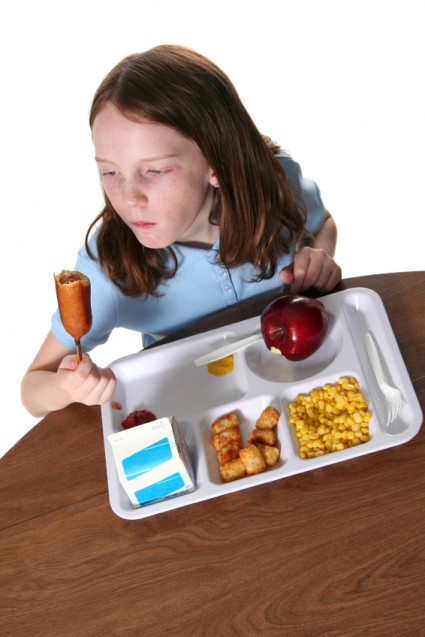 Are corndogs a vegetable? There has been a cultural revolution in this country over the last 50 to 75 years, a sort of intellectual cleansing that has removed from most people’s minds any understanding of food, of cooking, of the pleasures of the kitchen and table, and replaced it with the language of the drive-thru, the shopping mall, and the convenience store. Michael Pollan recently addressed this problem well.
Are corndogs a vegetable? There has been a cultural revolution in this country over the last 50 to 75 years, a sort of intellectual cleansing that has removed from most people’s minds any understanding of food, of cooking, of the pleasures of the kitchen and table, and replaced it with the language of the drive-thru, the shopping mall, and the convenience store. Michael Pollan recently addressed this problem well.
Nowhere is this more evident than in our schools, where our kids are not taught about food and cooking, not even the “Home Economics” of my high school years. No, instead the Iowa City Community School District (ICCSD) teaches something called “Family and Consumer Science.” There you have it — we are not raising citizens, we are raising consumers. Our children are being taught one way of surviving in this modern, fast-paced world: the way of conspicuous consumption.
A recent federal mandate required that every school district write and implement a “Wellness Policy” that addressed, among other things, the epidemic of obesity and childhood diabetes now rampant in our youth. This was a noble endeavor; however, it needed to be more than a mere academic and bureaucratic exercise. What is called for here is a true revolution, one that, like all revolutions, will be very difficult to conduct in the face of the stalwart forces of the status quo. The fear of change is a very difficult one to overcome.
Like all of us, our children are what they eat, and they cannot be expected to learn and grow effectively on fat, salt, and corn-sweetener-laden government-subsidized surplus. What is offered to them today is the result of the entrenched bureaucracy at the USDA, the immoveable object of parental indifference, and the irresistible force of union and administrative fear of change. Unlike the rest of the student’s school day, the lunch period is conducted not by the curricular side of the school system, but by the maintenance side. Meanwhile, the hardworking members of the ICCSD Food Service staff are restrained by inefficient kitchens, ludicrous time restraints, and a budget that is laughable at best. How well would you expect to eat on $1.60 per day?
We need a paradigm shift. From the parents and the rest of the taxpayers in the district, we need an understanding that spending more money is not “just throwing money at the problem,” it is an investment in the health and well-being of our children and our community. Parents must no longer choose to ignore the situation to the proven detriment of their children. From the teachers’ unions we need the flexibility to see that there are other models for the school day and the school year that can be effective besides the one we have in place, which was created over 100 years ago to fit an agrarian calendar so that kids could be home to tend to the farm when needed. The school year in the U.S. is 180 days long. It is 240 in Germany–and 243 in Japan. School days and even school weeks are longer too. A longer school day will provide the time necessary for children to eat healthily. Today they have 30 minutes or less, and most of that is spent standing in line.
If we move lunch away from the maintenance side of the equation and over to the curriculum, food will gain the attention that is necessary for it to demonstrate its own importance. We cannot continue to teach one thing in health class and peddle another in the lunch room. Teaching about food, its history, its culture, its etiquette, and its importance to our health and community will ensure a more productive and enjoyable future for our kids. To those who say “don’t try to tell me what I can and can’t feed my kids,” I say this: First, the USDA is already doing that, and in a demonstrably unhealthy way. Second, they may be your kids, but they’re our future.
This Labor Day, Slow Food USA will formally launch its Time for Lunch campaign with “Eat-Ins” scheduled all over the country — as of this writing, 227 in 49 states (step up, Mississippi!). In partnership with Sustainable Table, The Center for Ecoliteracy, Roots of Change, Edible Communities, and other organizations, Slow Food is calling on Congress, during its reauthorization of the Child Nutrition Act, to put real food on our children’s lunch trays. To do so, they must double the federal contribution to school lunches from $1 to $2 per meal.
Modeled on the sit-ins of the 60s, these Eat-Ins are potluck picnics to raise awareness. They are a call to action for our kids, alongside Slow Food’s signature celebration of local, sustainable, traditional food. Here’s a simple salad that’s delicious and ample enough to bring to to an Eat-In near you.
Anchovy, Goat Cheese and Romaine Salad
8 cloves garlic
1 teaspoon kosher salt
40 anchovy fillets — rinsed and chopped
6 ounces red wine vinegar
1 cup olive oil
1 teaspoon black pepper
6 heads romaine lettuce — rinsed and coarsely chopped
12 ounces fresh goat cheese — crumbled
1 cup red onion — minced
Place garlic, salt, and anchovy fillets in food processor; pulse until chopped. Add red wine vinegar, and then puree. Slowly add in olive oil while motor is running. Add black pepper. Toss greens with vinaigrette. Garnish with goat cheese and red onion.




